VOLVO S60 2009 Owner´s Manual
Manufacturer: VOLVO, Model Year: 2009, Model line: S60, Model: VOLVO S60 2009Pages: 254, PDF Size: 6.17 MB
Page 11 of 254

Introduction
Volvo and the environment
11
WARNING
CALIFORNIA proposition 65
Engine exhaust, some of its constituents,
and certain vehicle components contain or
emit chemicals known to the state of Cali-
fornia to cause cancer, and birth defects or
other reproductive harm. In addition, certain
fluids contained in vehicles and certain
products of component wear contain or
emit chemicals known to the State of Cali-
fornia to cause cancer, and birth defects or
other reproductive harm.Volvo is committed to the well being of its cus-
tomers. As a natural part of this commitment,
we care about the environment in which we all
live. Caring for the environment means an
everyday involvement in reducing our environ-
mental impact. Volvo's environmental activities
are based on a holistic view, which means we
consider the overall environmental impact of a
product throughout its complete life cycle. In
this context, design, production, product use,
and recycling are all important considerations.
In production, Volvo has partly or completely
phased out several chemicals including CFCs,
lead chromates, asbestos, and cadmium; and
reduced the number of chemicals used in our
plants 50% since 1991.
Volvo was the first in the world to introduce into
production a three-way catalytic converter witha Lambda sond, now called the heated oxygen
sensor, in 1976. The current version of this
highly efficient system reduces emissions of
harmful substances (CO, HC, NOx) from the
exhaust pipe by approximately 95-99% and
the search to eliminate the remaining emis-
sions continues. Volvo is the only automobile
manufacturer to offer CFC-free retrofit kits for
the air conditioning system of all models as far
back as the 1975 model 240. Advanced elec-
tronic engine controls and cleaner fuels are
bringing us closer to our goal. After Volvo vehi-
cles and parts have fulfilled their use, recycling
is the next critical step in completing the life
cycle. The metal content is about 75% of the
total weight of a vehicle, which makes the vehi-
cle among the most recycled industrial prod-
ucts. In order to have efficient and well-
controlled recycling, dismantling information is
available for all Volvo models. For Volvo, all
homogeneous plastic parts weighing more
than 3.4 oz. (100 grams) are marked with inter-
national symbols that indicate how the com-
ponent is to be sorted for recycling. In addition
to continuous environmental refinement of
conventional gasoline-powered internal com-
bustion engines, Volvo is actively looking at
advanced technology alternative-fuel vehicles.
When you drive a Volvo, you become our part-
ner in the work to lessen the car's impact onthe environment. To reduce your vehicle's
environmental impact, you can:
•
Maintain proper air pressure in your tires.
Tests have shown decreased fuel econ-
omy with improperly inflated tires.
•
Follow the recommended maintenance
schedule in your Warranty and Service
Records Information booklet.
•
Drive at a constant speed whenever pos-
sible.
•
See a trained and qualified Volvo service
technician as soon as possible for inspec-
tion if the check engine (malfunction indi-
cator) light illuminates, or stays on after the
vehicle has started.
•
Properly dispose of any vehicle-related
waste such as used motor oil, used batter-
ies, brake pads, etc.
•
When cleaning your vehicle, please use
genuine Volvo car care products. All Volvo
car care products are formulated to be
environmentally friendly.
For additional information regarding the envi-
ronmental activities in which Volvo Cars of
North America, LLC and Volvo Car Corporation
are involved, visit our Internet home page at:
http://www.volvocars.us.
Page 12 of 254

IntroductionVolvo and the environment
12
WARNING
Certain components of this vehicle such as
air bag modules, seat belt pretensioners,
adaptive steering columns, and button cell
batteries may contain Perchlorate material.
Special handling may apply for service or
vehicle end of life disposal.
See www.dtsc.ca.gov/hazardouswaste/
perchlorate.
Page 13 of 254

Introduction
Important warnings
13 Accessory Installation
•
We strongly recommend that Volvo owners
install only genuine, Volvo-approved
accessories, and that accessory installa-
tions be performed only by a trained and
qualified Volvo service technician.
•
Genuine Volvo accessories are tested to
ensure compatibility with the performance,
safety, and emission systems in your vehi-
cle. Additionally, a trained and qualified
Volvo service technician knows where
accessories may and may not be safely
installed in your Volvo. In all cases, please
consult a trained and qualified Volvo serv-
ice technician before installing any acces-
sory in or on your vehicle.
•
Accessories that have not been approved
by Volvo may or may not be specifically
tested for compatibility with your vehicle.
Additionally, an inexperienced installer
may not be familiar with some of your vehi-
cle's systems.
•
Any of your vehicle's performance and
safety systems could be adversely affec-
ted if you install accessories that Volvo has
not tested, or if you allow accessories to be
installed by someone unfamiliar with your
vehicle.
•
Damage caused by unapproved or
improperly installed accessories may not
be covered by your new vehicle warranty.
See your Warranty and Service RecordsInformation booklet for more warranty
information. Volvo assumes no responsi-
bility for death, injury, or expenses that
may result from the installation of nonge-
nuine accessories.
Driver distraction•
Driver distraction results from driver activ-
ities that are not directly related to control-
ling the vehicle in the driving environment.
Your new Volvo is, or can be, equipped
with many feature-rich entertainment and
communication systems. These include
hands-free cellular telephones, navigation
systems, and multipurpose audio systems.
You may also own other portable elec-
tronic devices for your own convenience.
When used properly and safely, they enrich
the driving experience. Improperly used,
any of these could cause a distraction.
•
For all of these systems, we want to pro-
vide the following warning that reflects the
strong Volvo concern for your safety:
•
Never use these devices or any feature of
your vehicle in a way that distracts you
from the task of driving safely. Distraction
can lead to a serious accident. In addition
to this general warning, we offer the fol-
lowing guidance regarding specific newer
features that may be found in your vehicle:
•
Never use a hand-held cellular telephone
while driving. Some jurisdictions prohibitcellular telephone use by a driver while the
vehicle is moving.
•
If your vehicle is equipped with a naviga-
tion system, set and make changes to your
travel itinerary only with the vehicle parked.
•
Never program your audio system while
the vehicle is moving. Program radio pre-
sets with the vehicle parked, and use your
programmed presets to make radio use
quicker and simpler.
•
Never use portable computers or personal
digital assistants while the vehicle is mov-
ing.
A driver has a responsibility to do everything
possible to ensure his or her own safety and
the safety of passengers in the vehicle and oth-
ers sharing the roadway. Avoiding distractions
is part of that responsibility.
Page 14 of 254
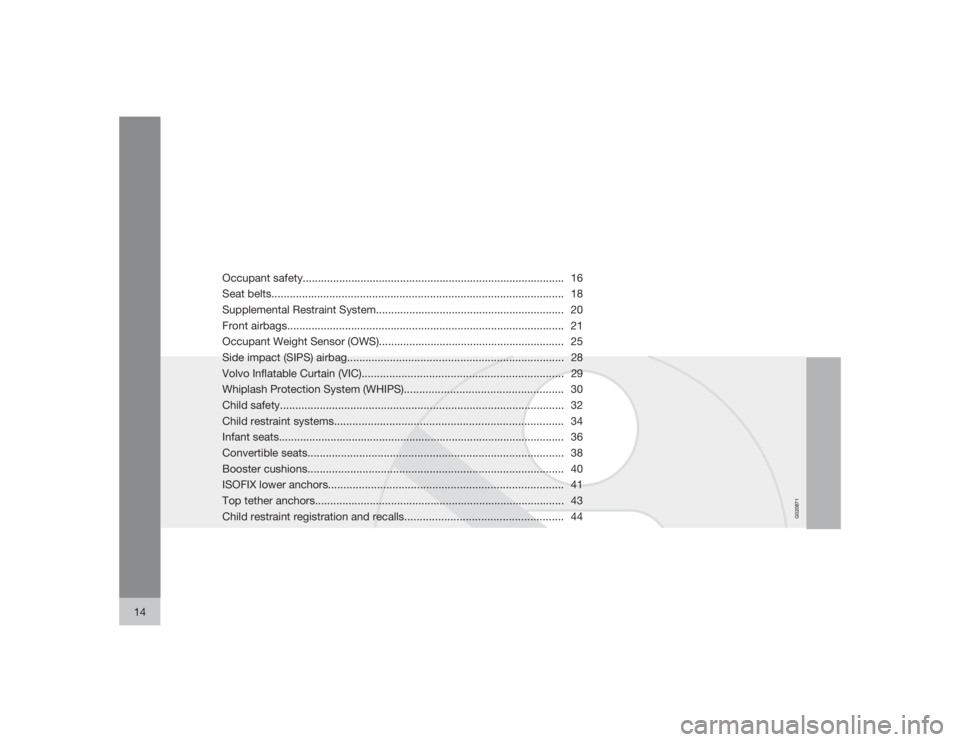
G020871
14
Occupant safety...................................................................................... 16
Seat belts................................................................................................ 18
Supplemental Restraint System.............................................................. 20
Front airbags........................................................................................... 21
Occupant Weight Sensor (OWS)............................................................. 25
Side impact (SIPS) airbag.......................................................................28
Volvo Inflatable Curtain (VIC)..................................................................29
Whiplash Protection System (WHIPS).................................................... 30
Child safety............................................................................................. 32
Child restraint systems........................................................................... 34
Infant seats.............................................................................................. 36
Convertible seats.................................................................................... 38
Booster cushions.................................................................................... 40
ISOFIX lower anchors............................................................................. 41
Top tether anchors.................................................................................. 43
Child restraint registration and recalls.................................................... 44
Page 15 of 254
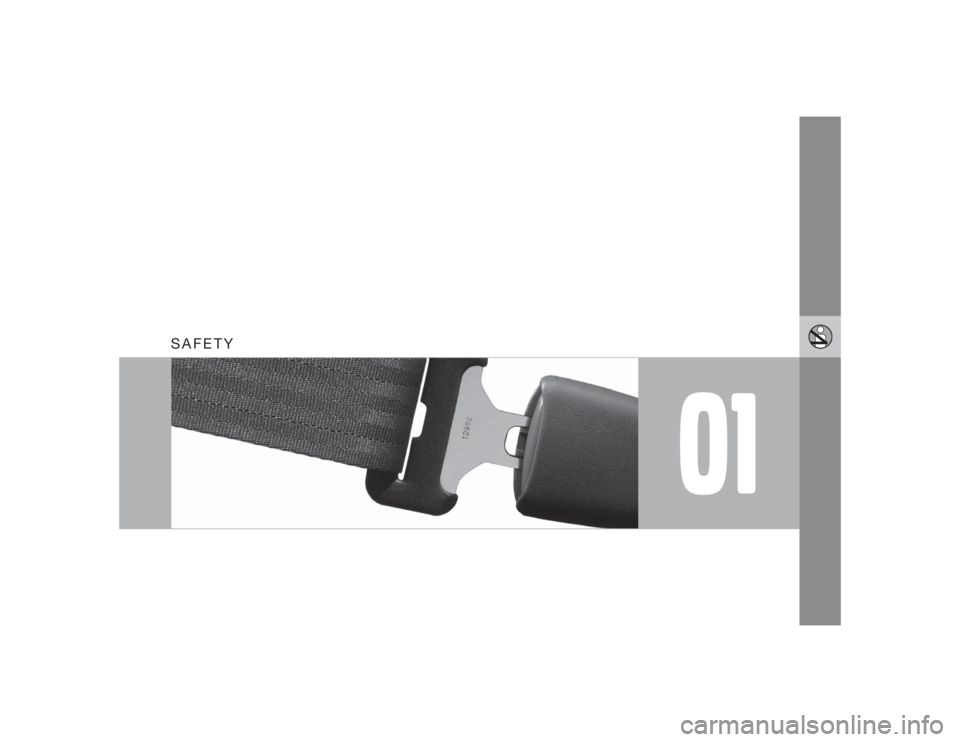
01
SAFETY
Page 16 of 254
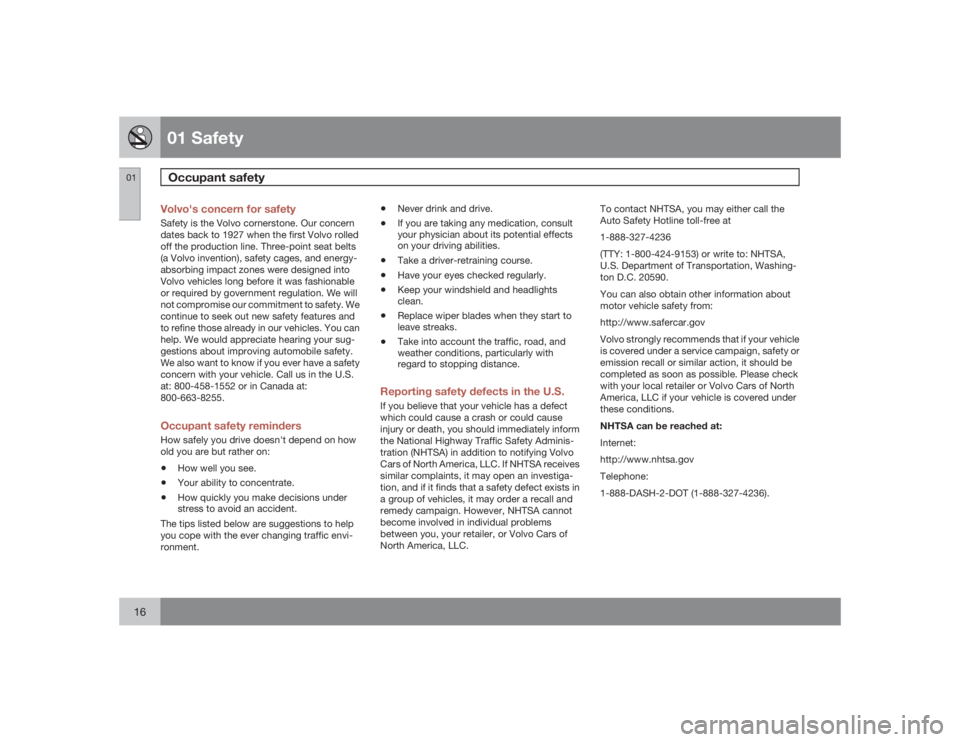
01 SafetyOccupant safety
0116
Volvo's concern for safetySafety is the Volvo cornerstone. Our concern
dates back to 1927 when the first Volvo rolled
off the production line. Three-point seat belts
(a Volvo invention), safety cages, and energy-
absorbing impact zones were designed into
Volvo vehicles long before it was fashionable
or required by government regulation. We will
not compromise our commitment to safety. We
continue to seek out new safety features and
to refine those already in our vehicles. You can
help. We would appreciate hearing your sug-
gestions about improving automobile safety.
We also want to know if you ever have a safety
concern with your vehicle. Call us in the U.S.
at: 800-458-1552 or in Canada at:
800-663-8255.Occupant safety remindersHow safely you drive doesn't depend on how
old you are but rather on:•
How well you see.
•
Your ability to concentrate.
•
How quickly you make decisions under
stress to avoid an accident.
The tips listed below are suggestions to help
you cope with the ever changing traffic envi-
ronment.
•
Never drink and drive.
•
If you are taking any medication, consult
your physician about its potential effects
on your driving abilities.
•
Take a driver-retraining course.
•
Have your eyes checked regularly.
•
Keep your windshield and headlights
clean.
•
Replace wiper blades when they start to
leave streaks.
•
Take into account the traffic, road, and
weather conditions, particularly with
regard to stopping distance.
Reporting safety defects in the U.S.If you believe that your vehicle has a defect
which could cause a crash or could cause
injury or death, you should immediately inform
the National Highway Traffic Safety Adminis-
tration (NHTSA) in addition to notifying Volvo
Cars of North America, LLC. If NHTSA receives
similar complaints, it may open an investiga-
tion, and if it finds that a safety defect exists in
a group of vehicles, it may order a recall and
remedy campaign. However, NHTSA cannot
become involved in individual problems
between you, your retailer, or Volvo Cars of
North America, LLC.To contact NHTSA, you may either call the
Auto Safety Hotline toll-free at
1-888-327-4236
(TTY: 1-800-424-9153) or write to: NHTSA,
U.S. Department of Transportation, Washing-
ton D.C. 20590.
You can also obtain other information about
motor vehicle safety from:
http://www.safercar.gov
Volvo strongly recommends that if your vehicle
is covered under a service campaign, safety or
emission recall or similar action, it should be
completed as soon as possible. Please check
with your local retailer or Volvo Cars of North
America, LLC if your vehicle is covered under
these conditions.
NHTSA can be reached at:
Internet:
http://www.nhtsa.gov
Telephone:
1-888-DASH-2-DOT (1-888-327-4236).
Page 17 of 254
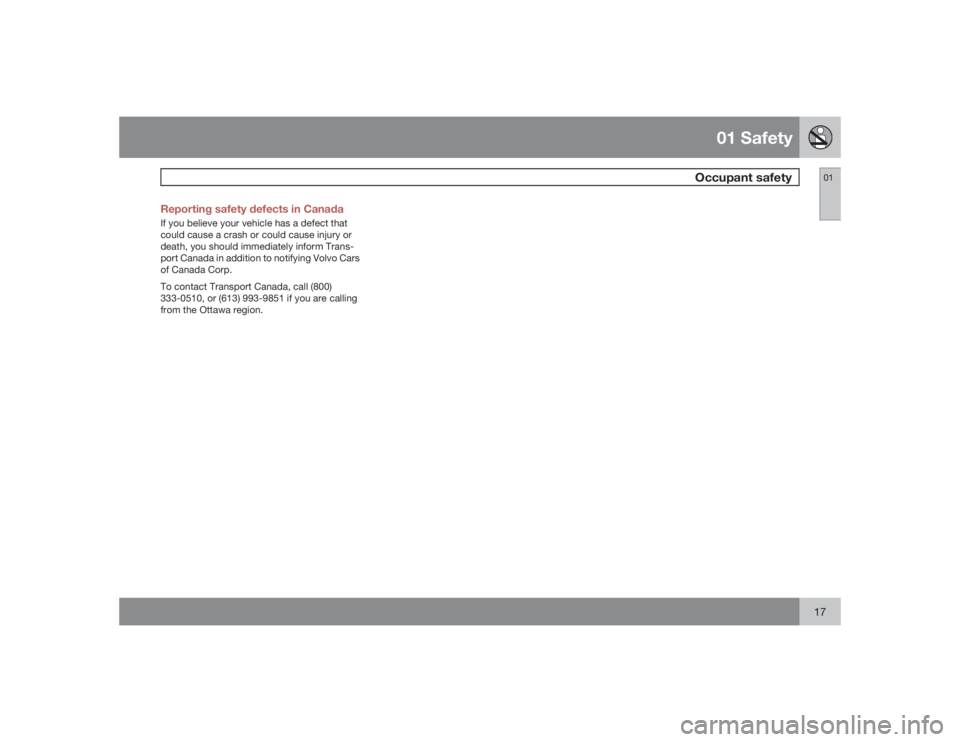
01 Safety
Occupant safety
0117 Reporting safety defects in Canada
If you believe your vehicle has a defect that
could cause a crash or could cause injury or
death, you should immediately inform Trans-
port Canada in addition to notifying Volvo Cars
of Canada Corp.
To contact Transport Canada, call (800)
333-0510, or (613) 993-9851 if you are calling
from the Ottawa region.
Page 18 of 254
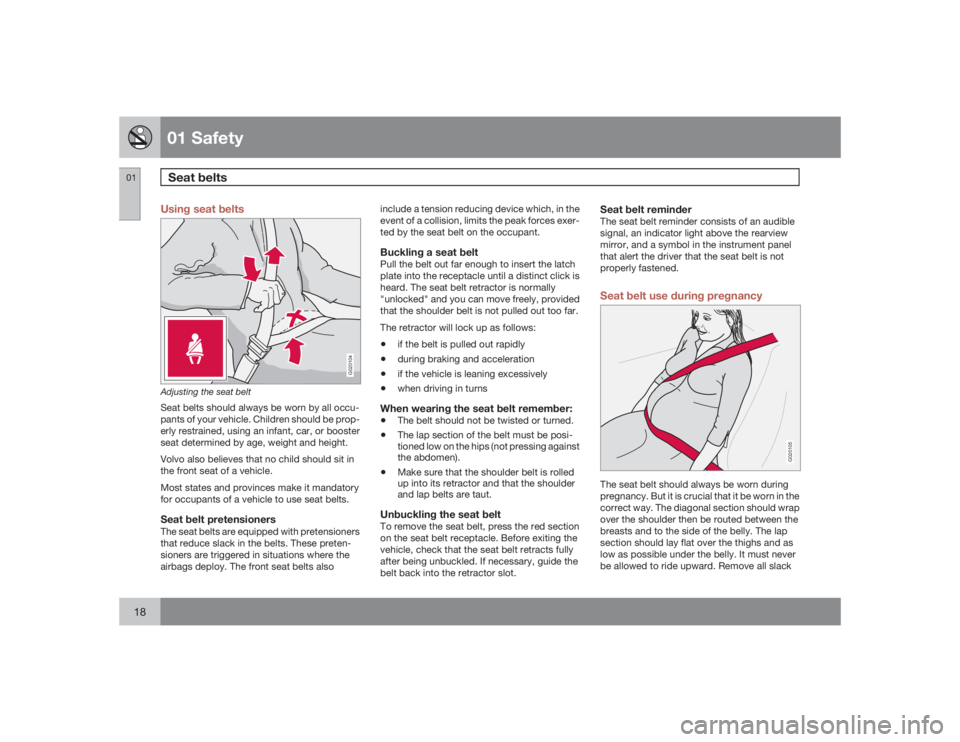
01 SafetySeat belts
0118
Using seat belts
G020104
Adjusting the seat beltSeat belts should always be worn by all occu-
pants of your vehicle. Children should be prop-
erly restrained, using an infant, car, or booster
seat determined by age, weight and height.
Volvo also believes that no child should sit in
the front seat of a vehicle.
Most states and provinces make it mandatory
for occupants of a vehicle to use seat belts.Seat belt pretensionersThe seat belts are equipped with pretensioners
that reduce slack in the belts. These preten-
sioners are triggered in situations where the
airbags deploy. The front seat belts alsoinclude a tension reducing device which, in the
event of a collision, limits the peak forces exer-
ted by the seat belt on the occupant.
Buckling a seat beltPull the belt out far enough to insert the latch
plate into the receptacle until a distinct click is
heard. The seat belt retractor is normally
"unlocked" and you can move freely, provided
that the shoulder belt is not pulled out too far.
The retractor will lock up as follows:•
if the belt is pulled out rapidly
•
during braking and acceleration
•
if the vehicle is leaning excessively
•
when driving in turns
When wearing the seat belt remember:•
The belt should not be twisted or turned.
•
The lap section of the belt must be posi-
tioned low on the hips (not pressing against
the abdomen).
•
Make sure that the shoulder belt is rolled
up into its retractor and that the shoulder
and lap belts are taut.
Unbuckling the seat beltTo remove the seat belt, press the red section
on the seat belt receptacle. Before exiting the
vehicle, check that the seat belt retracts fully
after being unbuckled. If necessary, guide the
belt back into the retractor slot.
Seat belt reminderThe seat belt reminder consists of an audible
signal, an indicator light above the rearview
mirror, and a symbol in the instrument panel
that alert the driver that the seat belt is not
properly fastened.Seat belt use during pregnancy
G020105
The seat belt should always be worn during
pregnancy. But it is crucial that it be worn in the
correct way. The diagonal section should wrap
over the shoulder then be routed between the
breasts and to the side of the belly. The lap
section should lay flat over the thighs and as
low as possible under the belly. It must never
be allowed to ride upward. Remove all slack
Page 19 of 254

01 Safety
Seat belts
0119
from the belt and insure that it fits close to the
body without any twists.
As a pregnancy progresses, pregnant drivers
should adjust their seats and steering wheel
such that they can easily maintain control of the
vehicle as they drive (which means they must
be able to easily operate the foot pedals and
steering wheel). Within this context, they
should strive to position the seat with as large
a distance as possible between their belly and
the steering wheel.Child seatsPlease see page 33 for information on secur-
ing child seats with the seat belts.Seat belt maintenanceCheck periodically that the seat belts are in
good condition. Use water and a mild deter-
gent for cleaning. Check seat belt mechanism
function as follows: attach the seat belt and pull
rapidly on the strap.
WARNING
•
Never use a seat belt for more than one
occupant.
•
Never wear the shoulder portion of the
belt under the arm, behind the back or
otherwise out of position. Such use
could cause injury in the event of an
accident.
•
Seat belts lose much of their strength
when exposed to violent stretching and
should be replaced after any collision,
even if they appear to be undamaged.
•
Never repair the belt yourself; have this
work done by an authorized Volvo serv-
ice technician only.
•
Any device used to induce slack into the
shoulder belt portion of the three-point
belt system will have a detrimental
effect on the amount of protection avail-
able to you in the event of a collision.
•
The seat back should not be tilted too
far back. The shoulder belt must be taut
in order to function properly.
•
Do not use child safety seats or child
booster cushions/backrests in the front
passenger's seat. We also recommend
that children who have outgrown these
devices sit in the rear seat with the seat
belt properly fastened.
Page 20 of 254

01 SafetySupplemental Restraint System
0120
Supplemental Restraint System (SRS)
G027284
SRS warning lightAs an enhancement to the three-point seat
belts, your Volvo is equipped with a Supple-
mental Restraint System (SRS). Volvo's SRS
consists of seat belt pretensioners, front air-
bags, side impact airbags, the occupant
weight sensor, and inflatable curtains. All of
these systems are monitored by the SRS con-
trol module. An SRS warning light in the instru-
ment panel (see the illustration) illuminates
when the ignition key is turned to position I,
II, or III, and will normally go out after approx-
imately 7 seconds if no faults are detected in
the system.Where applicable, a text message will also be
displayed when the SRS warning light illumi-
nates. If this warning symbol is not functioning
properly, the general warning symbol
illuminates and a text message will
be displayed.
WARNING
•
If the SRS warning light stays on after
the engine has started or if it illuminates
while you are driving, have the vehicle
inspected by a trained and qualified
Volvo service technician as soon as
possible.
•
Never try to repair any component or
part of the SRS yourself. Any interfer-
ence in the system could cause mal-
function and serious injury. All work on
these systems should be performed by
a trained and qualified Volvo service
technician.
WARNING
If your vehicle has been subjected to flood
conditions (e.g. soaked carpeting/standing
water on the floor of the vehicle) or if your
vehicle has become flood-damaged in any
way, do not attempt to start the vehicle or
put the key in the ignition before discon-
necting the battery. This may cause airbag
deployment which could result in personal
injury. Have the vehicle towed to a trained
and qualified Volvo service technician for
repairs.
Automatic transmission:
Before attempting to tow the vehicle, use
the following procedure to override the
shiftlock system to move the gear selector
to the neutral position:•
Switch off the ignition for at least
10 minutes and disconnect the battery
•
Wait at least one minute.
•
Insert the key in the ignition and turn it
to position II.
•
Press firmly on the brake pedal.
•
Move the gear selector from (P)ark to
the (N)eutral position.